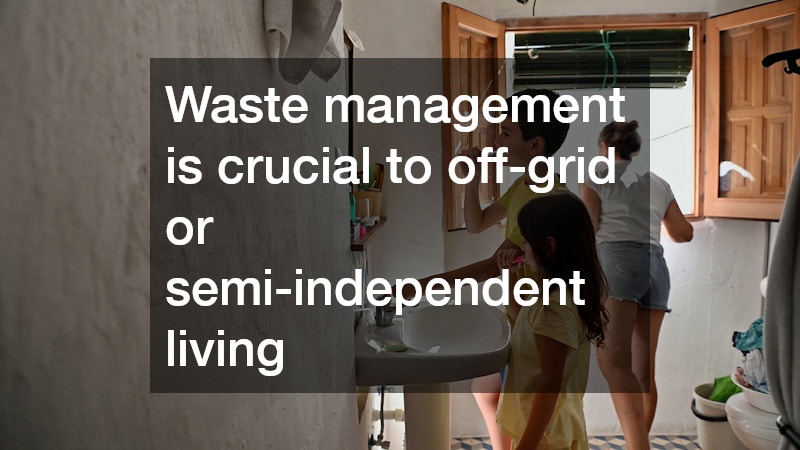
Guide to Constructing a Self-Sufficient Home
Building a self-sufficient home is an exciting yet challenging journey that blends practical construction planning with sustainable living goals. Whether you’re developing a rural property or converting an existing lot into a more independent homestead, each step requires careful coordination between multiple contractors and service providers.
A self-sufficient home doesn’t rely solely on city utilities—it generates or manages its own power, water, and waste systems. This approach not only reduces monthly costs but also increases property value and environmental responsibility.
From clearing the land and drilling for water to installing a septic system and designing energy-efficient heating, every stage plays a vital role. This guide will walk you through the essential contractors and services needed to build a self-sustaining home, what to expect from each, and how to choose the right professionals for your project.
Preparing the Land for Construction
Before any foundation is poured or materials are delivered, the first step in creating a self-sufficient home is preparing the site. Most raw land isn’t construction-ready. It may have trees, uneven ground, or drainage issues that must be addressed to ensure structural stability and long-term safety.
A land clearing service specializes in removing trees, brush, stumps, and debris from your property. They also handle grading and soil stabilization to make sure the area is ready for construction. Depending on your location, the process may require permits, especially if large trees or protected vegetation need removal. A reputable company will know local environmental regulations and can help secure the necessary documentation.
Once the land is cleared, excavating services take over. These professionals dig trenches for foundations, driveways, basements, and underground utilities. They’re also responsible for shaping the terrain so that water drains properly away from the home—critical for preventing flooding and foundation damage later.
When hiring site prep professionals:
-
Request a full property assessment before work begins.
-
Ask how they handle debris removal or recycling of organic materials.
-
Ensure they carry liability insurance and have experience with residential development.
-
Coordinate their schedule with surveyors and utility planners to avoid rework.
Proper site preparation sets the stage for the entire project. It ensures every contractor who follows—plumbers, electricians, builders—can work efficiently and safely.
Securing a Reliable Water Source
A self-sufficient home must have a dependable and clean water supply. For rural or off-grid properties, the most common and cost-effective solution is well drilling. This process involves drilling deep into the ground to access underground aquifers and installing a pump system that delivers fresh water to the home.
When planning your well, it’s important to consider factors like:
-
Depth and yield: The deeper the well, the more likely you’ll find stable, clean water—but costs also increase.
-
Placement: Wells should be located far from septic systems, animal enclosures, or chemical storage areas.
-
Casing and sealing: Proper sealing prevents contaminants from entering your water supply.
After drilling, well water testing becomes essential. Testing ensures the water is free of harmful bacteria, nitrates, heavy metals, and other pollutants. Initial testing should be done before using the water, and periodic re-testing—at least once a year—is recommended to maintain safety.
Helpful tips:
-
Always work with certified drillers who know local geological conditions.
-
Ask for a comprehensive water analysis rather than just basic testing.
-
Keep records of every test result and maintenance session for reference.
A properly designed well system with regular testing guarantees not only convenience but also peace of mind that your home’s water supply remains safe and sustainable.

Managing Waste and Sanitation Systems
Waste management is one of the most crucial aspects of off-grid or semi-independent living. For homes not connected to a municipal sewer line, a septic system is necessary to handle wastewater safely and efficiently.
Local septic companies specialize in designing and installing these systems. They evaluate your soil type, property layout, and household size to determine the right tank capacity and drain field configuration. These professionals handle everything from permitting to installation and long-term maintenance.
Meanwhile, excavating services play a supporting role by digging the required trenches and pits for the septic tank and leach field. Proper excavation is critical to ensuring that wastewater disperses evenly and doesn’t contaminate groundwater or nearby wells.
Maintenance and best practices include:
-
Have your septic tank inspected every three to five years.
-
Avoid flushing chemicals, wipes, or grease into the system.
-
Ensure drainage is directed away from the septic area to prevent overflow.
-
Keep a record of all maintenance and pumping schedules.
A well-planned septic setup contributes greatly to your home’s independence by managing waste safely without relying on municipal systems.
Heavy Equipment and Material Handling for Large-Scale Construction
Building a self-sufficient home often involves lifting large materials—roof trusses, steel beams, modular wall panels, and even solar arrays. For such tasks, homeowners or contractors frequently rely on crane rental services.
Crane rental allows you to use professional lifting equipment on a short-term basis without the massive investment of ownership. Operators typically come with full insurance, safety certifications, and experience handling heavy loads on residential sites.
At the same time, equipment rental plays a huge role in keeping costs manageable. Instead of buying specialized tools or machinery that you’ll only use once, you can rent them for days or weeks as needed. This might include compact loaders, backhoes, concrete mixers, or trenchers.
When coordinating heavy equipment use:
-
Schedule deliveries early and verify ground stability for crane positioning.
-
Ask rental companies about operator training or certified personnel.
-
Review insurance and damage policies before signing contracts.
-
Maintain clear communication between all site teams to avoid scheduling conflicts.
Renting the right equipment saves time and money while ensuring large-scale construction tasks are completed safely and efficiently.
Laying a Strong and Durable Foundation
Your home’s foundation is the most critical structural element—it supports everything above it. Building an energy-efficient and long-lasting home starts here, and concrete contractors are the experts who make it happen.
These specialists handle footings, slabs, driveways, and basement floors, ensuring everything is level, stable, and cured to perfection. Quality workmanship in concrete not only supports the home’s weight but also helps regulate temperature and moisture levels, improving long-term efficiency.
For those managing their own builds, equipment rental becomes an advantage during the foundation stage. Renting compactors, mixers, or finishing tools reduces labor costs and gives flexibility for DIY or partial contracting work.
Key foundation tips:
-
Request a soil analysis before pouring concrete.
-
Ensure proper reinforcement using steel rebar or mesh.
-
Allow adequate curing time to prevent cracks or shifting.
-
Hire concrete contractors experienced with energy-efficient foundation systems, such as insulated slabs.
A strong foundation ensures the home remains structurally sound, energy-efficient, and ready to handle decades of use.
Choosing Energy-Efficient Heating Systems
Heating and energy efficiency are at the heart of sustainable living. Choosing the right system can drastically reduce your dependence on external fuel sources and lower your energy bills year-round.
Furnace installation is often required even for self-sufficient homes, especially in colder climates. Modern high-efficiency furnaces can be integrated with renewable energy sources such as solar or geothermal systems. When selecting a furnace, homeowners should consider:
-
Fuel type (electric, propane, or hybrid systems).
-
AFUE (Annual Fuel Utilization Efficiency) rating.
-
System size relative to home square footage.
-
Compatibility with smart thermostats or alternative power sources.
For larger properties or multi-level homes, crane rental may be necessary during installation. Heavy heating units or venting systems often need to be positioned precisely in attics or mechanical rooms, and cranes make this process safe and efficient.
Additional heating efficiency tips:
-
Install proper insulation throughout the home.
-
Seal ductwork to minimize air leaks.
-
Schedule annual maintenance for peak performance.
-
Consider zoned heating systems to optimize comfort.
By investing in an efficient furnace system and professional installation, you ensure your self-sufficient home remains warm, comfortable, and cost-effective all year long.

Building Sustainable Outdoor Structures and Decking
Outdoor spaces are an extension of your self-sufficient home. They serve as gathering areas, garden spaces, or even platforms for solar arrays and water collection systems. Choosing durable and eco-friendly materials ensures that your outdoor features match the sustainability goals of your entire property.
Composite lumber has become the go-to material for decks, railings, and pergolas. Made from recycled wood fibers and plastics, it resists moisture, fading, and insects—making it a low-maintenance and long-lasting alternative to traditional wood. It’s ideal for homeowners who want to reduce maintenance while maintaining an attractive outdoor aesthetic.
Meanwhile, concrete contractors can assist in building patios, walkways, retaining walls, and outdoor seating areas. Concrete offers excellent durability and can be finished in a variety of textures and colors to blend naturally with composite materials.
Design and maintenance considerations:
-
Use composite decking for areas exposed to constant sunlight or rain.
-
Incorporate concrete footings for stability and safety.
-
Ensure proper drainage beneath decks and patios.
-
Clean composite surfaces seasonally to preserve their look.
These outdoor upgrades not only enhance your property’s livability but also add to its long-term sustainability and resale value.
The Importance of Coordination Between Contractors
Building a self-sufficient home requires teamwork and clear communication among multiple professionals. Each contractor’s work affects the next phase, so proper coordination is essential to avoid delays and costly mistakes.
For instance, the land clearing service must complete site preparation before excavation begins, but they should also coordinate with local septic companies to ensure the septic area remains undisturbed. Similarly, well drilling should occur before final grading or driveway construction to prevent access issues for large drilling equipment.
To keep projects organized:
-
Create a timeline that outlines which contractors work first and how their tasks overlap.
-
Hold regular coordination meetings to review progress.
-
Assign a general contractor or project manager to oversee the entire process.
-
Keep all permits, blueprints, and inspection records accessible to everyone involved.
When contractors communicate effectively, projects move smoothly and costly rework is avoided. This level of organization is especially important in sustainable homebuilding, where one system (like water or septic) can easily impact another.
Maintaining Long-Term Self-Sufficiency
Once your home is fully built and operational, the real test of self-sufficiency begins with ongoing care. Building an independent property is only the first step—preserving its systems, efficiency, and resilience over time is what makes it truly sustainable. Proper maintenance ensures your home continues to provide comfort, clean water, and reliable utilities for decades, even in changing conditions.
Water systems are one of the most critical elements to maintain. Regular well water testing should be part of your annual schedule, even if your water initially tested clean. Over time, shifts in groundwater, nearby land use, or natural sediment changes can introduce new contaminants. Testing helps detect bacteria, heavy metals, and other pollutants early, allowing you to address issues before they affect your health or plumbing systems. Keeping records of test results also helps track long-term water quality trends and provides useful data if you ever sell the property.
Heating systems deserve equal attention. A furnace installation may seem like a one-time task, but maintaining its performance is essential for both comfort and efficiency. Schedule seasonal tune-ups to inspect burners, fans, and filters. A dirty or neglected furnace can lose up to 20% of its efficiency, driving up utility costs and straining other systems in your home. Replacing air filters every few months and inspecting vents for blockages ensures proper airflow. For homeowners committed to sustainability, integrating the furnace with renewable energy solutions—such as solar-assisted heating or geothermal loops—can dramatically reduce long-term operating costs and carbon emissions.
A thoughtful maintenance routine covers every corner of the home, not just water and heat. Here are a few ongoing tasks to prioritize:
-
Annual water testing and septic inspections to ensure both supply and waste systems remain safe and efficient.
-
Seasonal HVAC servicing to maintain energy performance and prevent costly breakdowns.
-
Insulation and weatherproofing checks before cold seasons to reduce heat loss and moisture intrusion.
-
Gutter and drainage cleaning to prevent water accumulation and foundation damage.
-
Upkeep of outdoor structures made with composite lumber or concrete, ensuring they remain stable, weather-resistant, and visually appealing.
Routine upkeep isn’t just about preventing breakdowns—it’s about preserving the integrity of your self-sufficient systems. When each component, from water to heating to structural materials, is cared for consistently, your home remains resilient against changing climates, shifting soil, and everyday wear.
A self-sufficient home represents freedom, resilience, and a deep respect for the environment. But creating one requires careful planning, skilled professionals, and long-term commitment. From preparing the land to ensuring clean water and efficient heating, every phase plays a crucial role in achieving full independence.
By working with experienced contractors, investing in quality materials, and keeping up with maintenance, homeowners can enjoy the peace of mind that comes from knowing their home is not only built to last but also designed to thrive—sustainably and responsibly—for generations to come.
You may also like
Written by Remodel Digest
Archives
- October 2025
- September 2025
- August 2025
- July 2025
- June 2025
- May 2025
- April 2025
- March 2025
- February 2025
- January 2025
- December 2024
- November 2024
- October 2024
- September 2024
- August 2024
- July 2024
- June 2024
- May 2024
- April 2024
- March 2024
- February 2024
- January 2024
- December 2023
- November 2023
- October 2023
- September 2023
- August 2023
- July 2023
- June 2023
- May 2023
- April 2023
- March 2023
- February 2023
- January 2023
- December 2022

